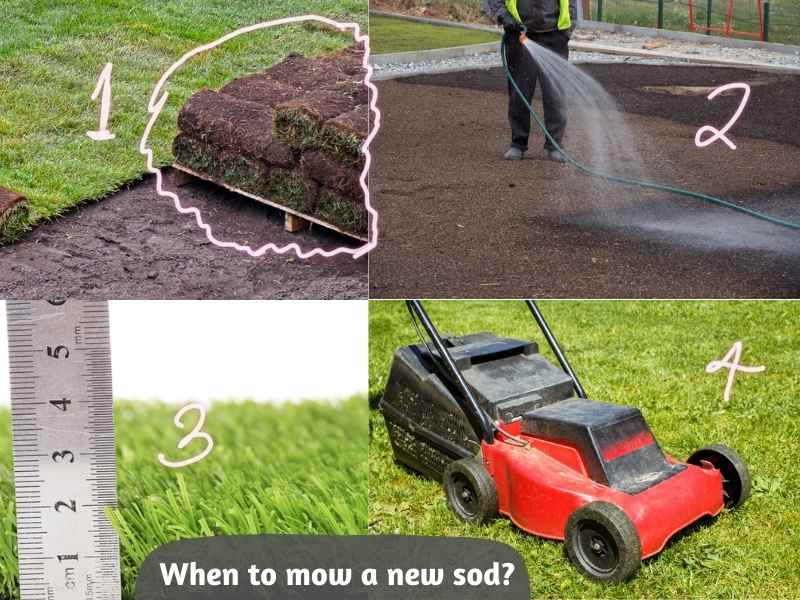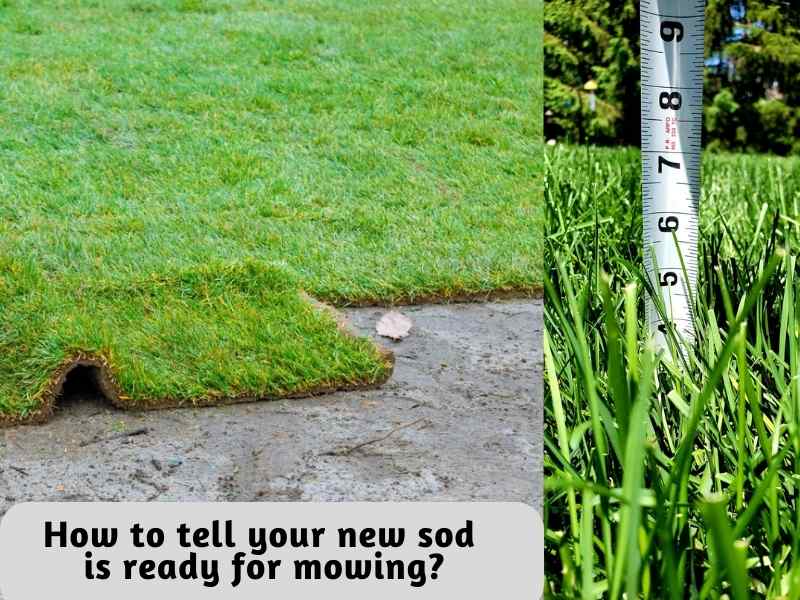When to Mow a New Sod: How Long Should You Wait?
Having successfully installed new sod and following the essential lawn care procedures ensures fast growth of the new lawn. Regular watering after installation and applying a slow-release fertilizer, you begin to notice a significant amount of grass growth. However, when is the best time to mow the new sod?
Mowing too early before roots anchorage would destroy the lawn, while too late results in unhealthy-weak turf lawn. Mow a newly-installed sod lawn at 3-6 weeks to maintain the lawn and reduce the risk of ruining it.
Here, I’ll go through when to mow a new sod and how to tell the right time to mow.
When to mow a new sod?
Mowing a newly installed lawn at the right height and time determines the overall success of your lawn establishment. Mowing your turfgrass has multiple benefits for your lawn and overall curb appeal. A well-manicured lawn with uniform-height grass is attractive. Frequent mowing boosts dense growth, helps choke out weeds, and keeps off certain pests that thrive in the long grass.

- Initial mowing– depending on the particular type of turf grass you’re growing on your lawn. It should take 7-42 days for the sod to reach proper anchorage that can withstand mowing. Lawn care routines; frequent watering after installation, minimizing foot traffic, and applying slow-release nitrogen fertilizer after sod installation can speed up the rate at which your newly-established sod takes root.
- Regular mowing– after initial mowing, subsequent, regular mowings are best undertaken when daily temperatures are at their lowest. Typically early mornings or late evenings since mowing during hot weather can stunt grass growth.
When mowing new sod, follow the procedure below:
- The right time to mow your new sod lawn is between 8:00 am to 10:00 am when the grass dew has dried up.
- Set the lawn cutting height to about three inches, as you only want to cut back about a third of the length of the grass blades with each mowing session. Setting lower cutting heights will take off more of the blade surface area, thus hampering photosynthesis and affecting plant growth.
- Use a lightweight mower to avoid peeling back the new sod for the initial mowing. A push (walk-behind) power mower is appropriate since its lightweight compared to heavier riding mowers.
- Practice leaving grass clippings on the lawn to provide nutrients for the roots. It’s also a good practice to apply potash (potassium helps deep root development) during sod installation to enhance root development.
How to tell your new sod is ready for mowing
The worst thing you would do is to mow the new sod too early since it most likely results in grass damage. Mowing before the sod is well-established into the soil leads to the peeling back of entire sod patches. You should, therefore, consider mowing after the grass’s root system has been well-established.

Remember, some sod varieties develop lush green growth just a few days after installation. Which might trick you into thinking that your turf is ready to be mowed- when it’s not. While sod may develop roots as early as within a few days post-installation, the roots are too shallow to hold the sod from being peeled back by powerful lawn mower blades. What’s more, depending on soil conditions and moisture content, the newly-installed sod may take a week to six weeks to firmly establish. It’s important, therefore, to gauge whether your newly-installed sod is ready for mowing by carrying out a root attachment test.
Note: You can undertake the root establishment test for your turfgrass from the start of the second-week post-installation. Try to remove a few grass plants and observe the results using minimal force. If most of the grass maintains a firm hold, then it’s ready to be mowed. However, if it uproots with just a little application of force, you should consider waiting a while longer before mowing.
How to care for new sod after mowing
Here are the “Do’s and Don’ts” of newly installed lawns after mowing:
- Water less often– after the initial mowing, your newly installed sod will benefit from less irrigation. Normally, three watering sessions per day should be enough at this stage to avoid soggy lawns.
- Water when temperatures cool down– the best time to water your lawn grass post-mowing is when there’s minimal evaporation. That’s usually in the mornings before 10 am or evenings. The low evaporation rate allows for more water to drain into the soil, consequently facilitating root growth of the grass.
- For already mowed lawns with an established root system, water on alternate days. Scale down watering frequency to once per day for every three days, a month post-installation, or with three-four mowings.
Read Also: When to Start Walking on New Sod: How Long to Wait for You + Pets
What happens if you don’t mow a new sod?
If you don’t mow your new sod at the appropriate intervals, the most obvious effect is long, unsightly lawn grass. But that’s not the only problem, as leaving your grass uncut also affects the health of the root systems.
Here’s a detailed look at each of the above negative effects of not mowing your lawn grass:
Unattractive lawn grass
Tall/overgrown lawn grass has an unsightly appearance, which is compounded by the inconsistent height of the individual grass blades. With continued lack of mowing, the seeding period comes in, and the grass blades assume a weed-like appearance. Very tall lawn grass water down your home’s curb appeal but also risks attracting legal fines from local authorities. Research if you live in a city that requires residents to keep their lawn grass mowed/no longer than a given height.
Uncut grass grows long and thin, and you’ll likely end up with bare spots on your lawn. By contrast, frequent mowing triggers the production of new shoots. The new shoots and leaves restore grass photosynthesis, resulting in a visually appealing-denser turfgrass appearance. High turf density is good for aesthetic and functional purposes, while denser turfgrass is more resistant to wear from high foot traffic or other physical stressors.
Unhealthy lawn grass
This occurs when you fail to mow your new sod at the appropriate time period and then attempt to rectify the mistake by mowing one-third of the total blade length of the grass. This causes a drop in the growth rate of the root systems, consequently resulting in weaker grass that’s more vulnerable to pests and diseases.
Failing to mow, on the other hand, encourages the continued growth of weeds that compete for valuable soil nutrients with your turfgrass, consequently hampering the growth and health of your grass. You should- therefore- ensure timely mowing after planting your new sod to ensure the grass stays healthy.


